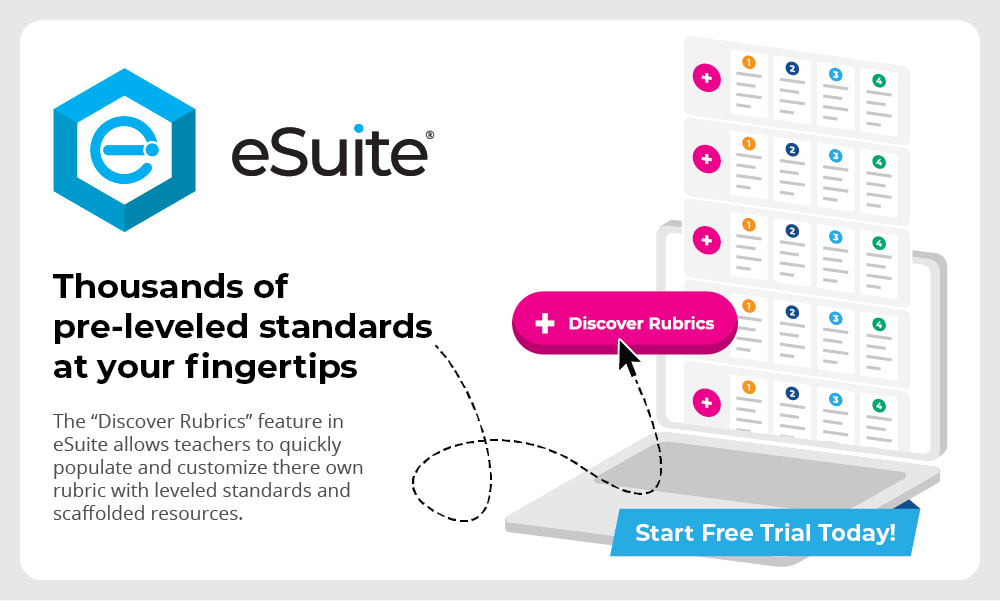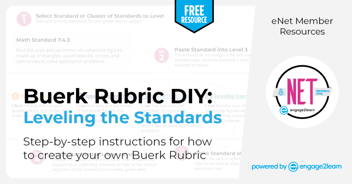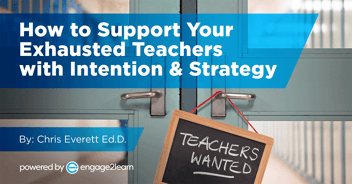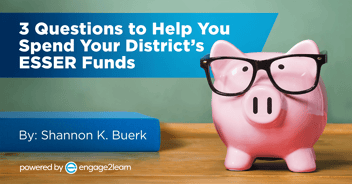Mitigating Disrupted Learning: It's About Time
Every ed leader I talk to is beyond weary with the never-ending challenges of a shifting landscape in this highly-irregular, pandemic-driven ‘20-’21 school year. The Herculean and persistent efforts of educators everywhere are so impressive, yet the data from grades, mid-year assessments, etc., is showing the effects of disrupted learning on students across the board.
Districts are reporting high failure rates and 30 to 75 percent learning loss, which is stacked on top of the losses from last spring where we saw the slide start, as the graph below indicates. RAND surveys, conducted by American Educator Panels (AEP) in October 2020, found “on average, teachers reported being able to contact only four out of every five students. Only 59% of teachers reported assigning letter grades during fall 2020.” The survey also stated that “principals in the highest-poverty schools reported that, on average, only 80% of their students had adequate internet access at home.”
It’s clear the remote learning environment has exacerbated inequities in educational access and outcomes over the last several months as students without supervision have fallen farther behind. Furthermore, the long-term impact as a result of school closures could take years to recover from, according to a study conducted by The Center for Research on Education Outcomes (CREDO) at Stanford University.
To make up for what looks to be 18 months of limited or outright lost learning time, educators have to find the most efficient and effective path to accelerating learning for every student.

Time Is Too Precious to Waste!
At this point, we have to use every minute of learning time efficiently. We will have to convert our typical ways of thinking and apply the same treatment to all learners, whether they need it or not. I remember when my daughter was in high school, she told me a story of when they had to write a research paper. Her teacher asked the class if they knew how to do a Google search. (Hard to imagine a time when anyone would need to ask that question, I know, but it was only about eight years ago.) The class answered that they did know how to conduct a Google search. The teacher then used 20 minutes to have the entire class take notes on how to conduct a Google search. Twenty minutes x 30 students = 600 wasted minutes + the teacher time to design and perform that lesson.
While this is a dated example, the methodology of providing the same curriculum to everyone standard by standard still persists today and has not been changed by using an LMS or sit-and-get instruction on a computer. As long as we offer the same activities, resources, and lessons to all students, learners who need more time on certain concepts or standards fall farther and farther behind. It is also not a sustainable solution to ask or require students who are behind to spend countless hours, in addition to the 6-8 hours of school time, in tutoring to catch up.
If we want to mitigate the effects of disrupted learning and get students back on track, it's imperative that we maximize efficiency for every student to learn by removing the barriers of whole group assignments and activities. Time is too precious of a commodity right now and we simply do not have time to waste. So let’s stop doing things that are wasting time!
There is one simple solution to this complex problem: Each student needs more time during the allotted classroom time that is exactly matched to their individual learning needs and gaps.

Of course, the first thing that comes to mind when thinking of individualized learning pathways is that teachers do not have enough time to design all of these individualized pathways to meet individual needs. This means that if we want to solve the problem of time for students, we must first solve the problem of time for teachers. What if there was a way to create a learning environment where students have the data available to make their own informed decisions about how to spend their time? Students would be guided by a teacher who is free from “managing the class” and has designed leveled options for each student to use to create an individualized “playlist” that matches individual learning needs and gaps.
This autonomous environment can utilize every minute of class time to accelerate learning, and it is not as difficult as you may think.
5 Things We Can Abandon to Free Up Time & Mitigate Disrupted Learning
To create this type of learning environment, we have to do what the late Sir Ken Robinson said over a decade ago: “Let’s remove the barriers to learning and stop doing anything that gets in the way.“ Just by abandoning some things to free up the time for individual mastery, we will be well on the way to enhanced student success — and who doesn’t want to take things off the plate right now? Based on research about how people learn and how students achieve, here is what can be strategically abandoned and what to do instead:
| Time Saved… | Abandon | Instead, try… | Research Resources |
| By teacher By learner |
Google searches for resources that are not categorized as ‘High Quality Instructional Materials’ | Limiting all resources to HQIM only; better to do nothing and do no harm than use materials that are not high quality | Edreports.org Why HQIM Matter |
| By teacher By learner |
“Whole class” assignments | Sort activities based on alignment to leveled standards | How to Put It All Together |
| By teacher By learner |
Making assignments prior to pre-assessment | Leveled pre-assessments that provide quick data on which standards and on which level of those standards each student needs to start | How Assessing More and “Testing” Less is Right for Kids How Pre-Assessments Ease the Burden of Distance Learning |
| By teacher By learner |
Homework assignments on paper or computer | Activities that connect students to their families and the outdoors to gain more background knowledge and increase language acquisition | Learning Should Be Real Not “Real” Why Are We Learning This? |
| By teacher By learner |
Synchronous remote teaching or whole group in-person teaching | Micro-teaching + Small group instruction in person or virtually based on formative assessment data | Direct Instruction in a Small Group Environment The Science of Small Group Instruction How to Make Remote Learning Work for Every Learner! e2L Learning Model and Protocols |
How to Put It All Together
With the found time, the approach that will be the most efficient in accelerating student learning is to truly differentiate the learning pathway in the most direct way possible: by standard. Most of the time, we are differentiating instruction by varying modalities or creating choices in activities, but these ways of differentiating do not tie directly to the standards for mastery. To get at the heart of accelerating standards mastery, it is critical to look at the standards themselves and differentiate those for students. See the three steps below that will lead to an engaging and autonomous mastery learning environment.
1. Level High Priority Standards
We have been using this elegant solution for 10 years at engage2learn to differentiate Tier 1 instruction by scaffolding or leveling the high priority standards to create leveled rubric trackers that generate four unique entry points per standard. A leveled rubric tracker (which my team affectionately calls a “Buerk Rubric,” because it is literally our secret sauce to getting amazing results with all learners!) is a growth-based learning system that allows for an autonomous path to mastery and beyond!
Creating a Buerk Rubric isn’t as hard as you may think, in fact we have created a FREE resource detailing the simple 4-step process we use to create them. Click the link below to download our Buerk Rubric DIY now.
Once the standards are leveled, teachers can use them to prepare lessons and assessments. Learners can quickly identify their unique entry points and set goals as a result of a teacher-administered, standards-aligned leveled pre-assessment. If you want more info on leveled pre-assessments, see How Pre-Assessments Ease the Burden of Distance Learning. This blog is written by one of our e2L-certified coaches who implemented our e2L competency-based framework in her classroom in a Texas school district.
No longer will instructional time be wasted, because everyone’s entry point for their personalized learning path will be made clear. If you want more details on how to build these leveled Buerk Rubric trackers, reach out — we can help. Please drop a comment below or contact me directly at shannon@engage2learn.org.

2. Align Resources and Learning Options to Each Level
Next, teachers use the leveled standards to create a tracking tool that students can use as a personalized playlist for each lesson/unit. Each leveled standard should be accompanied by aligned resources and differentiated options for learning. Students use the knowledge gained from the available aligned resources and learning options to ‘level up’ in their personalized playlist as they work towards mastery of the standard. If you are currently an eSuite subscriber, you can use the “Discover Rubrics” button to find leveled standards already created for you for just about every subject and grade. See the graphic below.
Differentiating learning options gives students choices and allows them to build learner agency by identifying what best resonates with their preferred learning style. When students are empowered to own the learning process by having a choice, engagement rates go through the roof!
3. Use Leveled Standards to Guide Learning
As students level up in their ‘personalized playlist’ teachers can now abandon whole group instruction and repurpose that precious time for small group instruction, individual intervention, and conducting formative assessments, all as part of Tier 1 instruction.
Providing regular formative assessments such as quick checkpoints before students level up in their ‘personalized playlist’ 1) ensures that learning gaps are caught way before the end of a lesson/unit, and 2) allows both the teacher and student to engage in feedback and celebrate growth! Formative assessments should be designed to show progress on the standard and are embedded throughout the project or unit.
For more information on assessing student progress, see How Assessing More and “Testing” Less is Right for Kids, written by our very own eGrowe Coach, Robyn Scott.
It’s About Time!
Imagine if we apply these three steps to our Google search lesson example above. Students would have taken a quick pre-assessment on their skills to conduct a Google search, how to choose appropriate resources, and the writing skills to be applied in the research paper. Then, based on the results, each student would engage in learning activities matched to their ‘personalized playlist’ with the teacher formatively assessing progress along the way as they leveled up. No time wasted for anyone. We all want to make sure that we can mitigate the damage from 2020, but to do this, we have to stop wasting time and accelerate learning for every student. The most efficient and effective way to do this is by differentiating the entry points and resources by standard so that no time is wasted.
Now that you have heard our solution, please share your ideas with us and with others! If you want to know how to level standards, which is a key component of mitigating disrupted learning, reach out to Start Your Partnership with engage2learn today!



